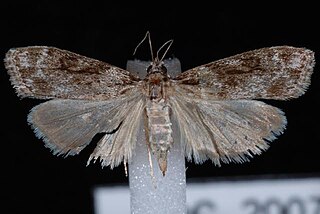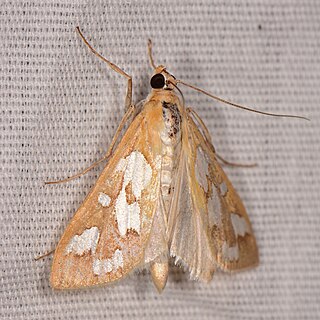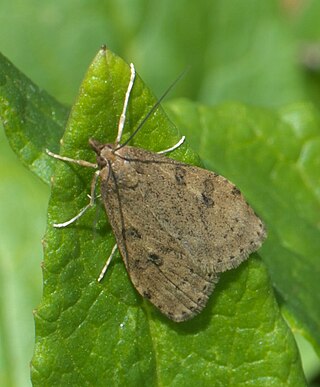
The Pyraloidea are a moth superfamily containing about 16,000 described species worldwide, and probably at least as many more remain to be described. They are generally fairly small moths, and as such, they have been traditionally associated with the paraphyletic Microlepidoptera.

Neodactria is a genus of moths of the family Crambidae.

Dioryctria auranticella, the ponderosa pineconeworm moth, is a moth of the family Pyralidae. The species was first described by Augustus Radcliffe Grote in 1883. It is found in western North America from southern British Columbia south to California and Arizona, east to South Dakota and New Mexico.
Dioryctria tumicolella is a species of snout moth in the genus Dioryctria. It was described by Akira Mutuura, Eugene G. Munroe and Douglas Alexander Ross in 1969, and is known from British Columbia, Canada, but is possibly present in all of north-western North America.
Alexander Barrett Klots was an American entomologist who specialised in Lepidoptera.
Neodactria daemonis is a moth in the family Crambidae. It was described by Bernard Landry and Alexander Barrett Klots in 2005. It is found in North America, where it has been recorded from Devil's Den State Park in Arkansas and Missouri.
Neodactria glenni is a moth in the family Crambidae. It was described by Bernard Landry and Alexander Barrett Klots in 2002. It is found in North America, where it has been recorded from central and east-central Missouri, upper central Illinois and eastern Mississippi. The habitat consists of prairies.

Neodactria luteolellus, the mottled grass-veneer, is a moth in the family Crambidae. It was described by James Brackenridge Clemens in 1860. It is found in North America, where it has been recorded from Labrador and Quebec to North Carolina, west to Arizona and California and north to Alberta. The habitat consists of grassland areas in prairies, aspen parklands and boreal forests.
Neodactria oktibbeha is a moth in the family Crambidae. It was described by Bernard Landry and Richard L. Brown in 2005. It is found in central Mississippi, where it is only known from prairie remnants in the Black Belt of Oktibbeha and Lowndes counties.
Daulia arizonensis is a moth in the family Crambidae. It was described by Eugene G. Munroe in 1957. It is found in North America, where it has been recorded from Arizona and Texas. In the south, the range extends from Mexico to Argentina.

Pyrausta unifascialis, the one-banded pyrausta, is a moth in the family Crambidae. It was described by Alpheus Spring Packard in 1873. It is found in North America, where it has been recorded from Quebec west to British Columbia, south to Arizona and California. The habitat consists of forest openings, clearings and fields.

Saucrobotys futilalis, the dogbane saucrobotys moth, is a moth in the family Crambidae. It was described by Julius Lederer in 1863. It is found in North America, where it has been recorded from the north-east to British Columbia and south to Texas and California.

Eudonia spenceri is a moth in the family Crambidae. It was described by Eugene G. Munroe in 1972. It is found in North America, where it has been recorded from California and Arizona to Montana and British Columbia.
Eudonia duospinata is a moth in the family Crambidae. It was described by Wei-Chun Li, Hou-Hun Li and Matthias Nuss in 2012. It is found in China and Taiwan.
Eudonia furva is a moth in the family Crambidae. It was described by Wei-Chun Li, Hou-Hun Li and Matthias Nuss in 2012. It is found in Yunnan, China.
Eudonia zhongdianensis is a moth in the family Crambidae. It was described by Wei-Chun Li, Hou-Hun Li and Matthias Nuss in 2012. It is found in Yunnan, China.

Frechinia helianthiales is a moth in the family Crambidae. It was described by Mary Murtfeldt in 1897. It is found in North America, where it has been recorded from Arizona, Illinois, Manitoba, Missouri and Oklahoma, south to Mexico.

Diastictis robustior is a species of moth in the family Crambidae. It was described by Eugene G. Munroe in 1956. It is found in North America, where it has been recorded from Arizona, Nebraska, Oklahoma and South Dakota.
Sufetula diminutalis is a snout moth in the subfamily Lathrotelinae of the family Crambidae. It was described by Francis Walker in 1866 in the genus Isopteryx from material collected in Honduras.

Udea turmalis is a moth in the family Crambidae. It was described by Augustus Radcliffe Grote in 1881. It is found in North America, where it has been recorded from Alberta, Arizona, British Columbia, California, Colorado, Idaho, Manitoba, Montana, Nevada, New Mexico, Utah and Washington.








